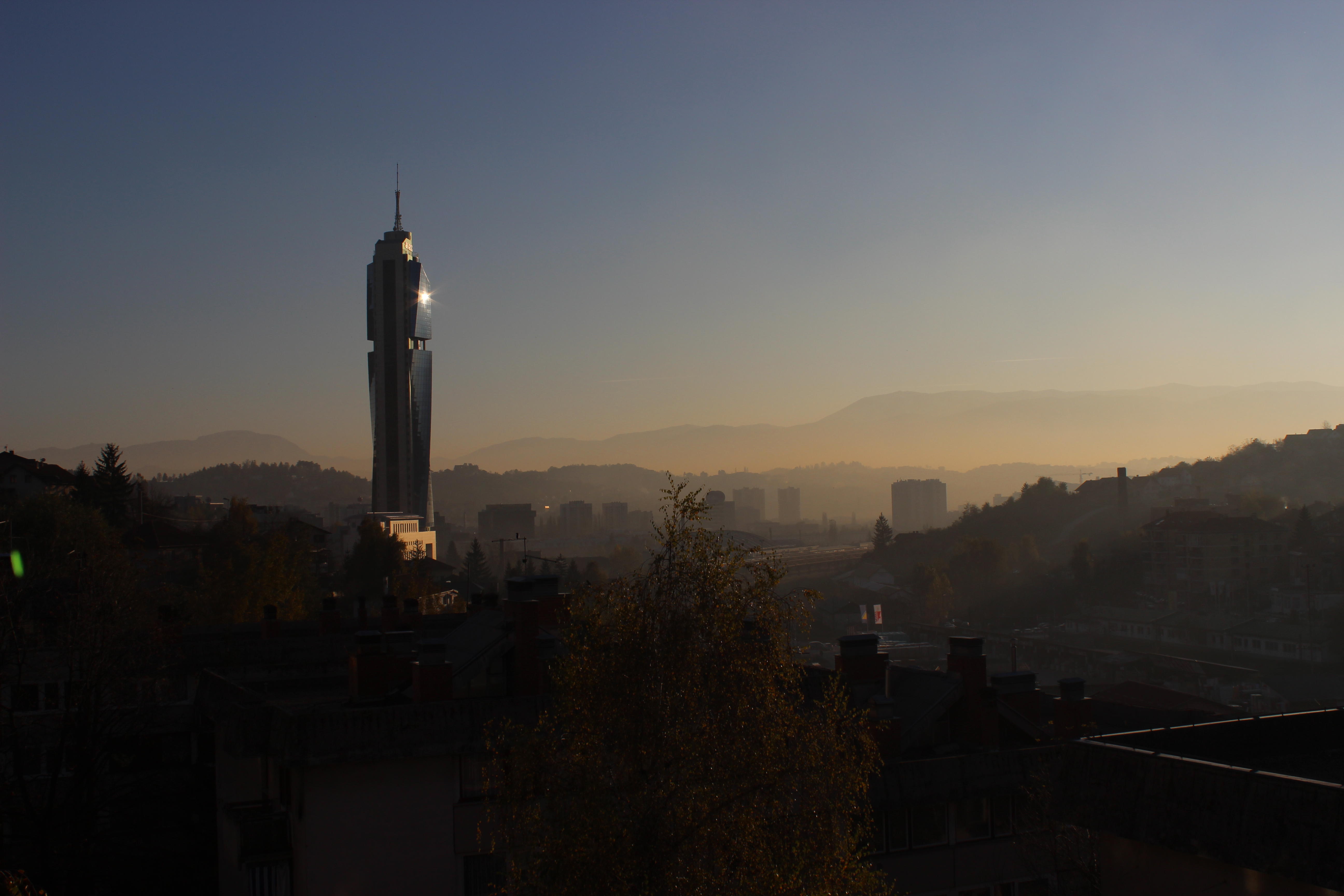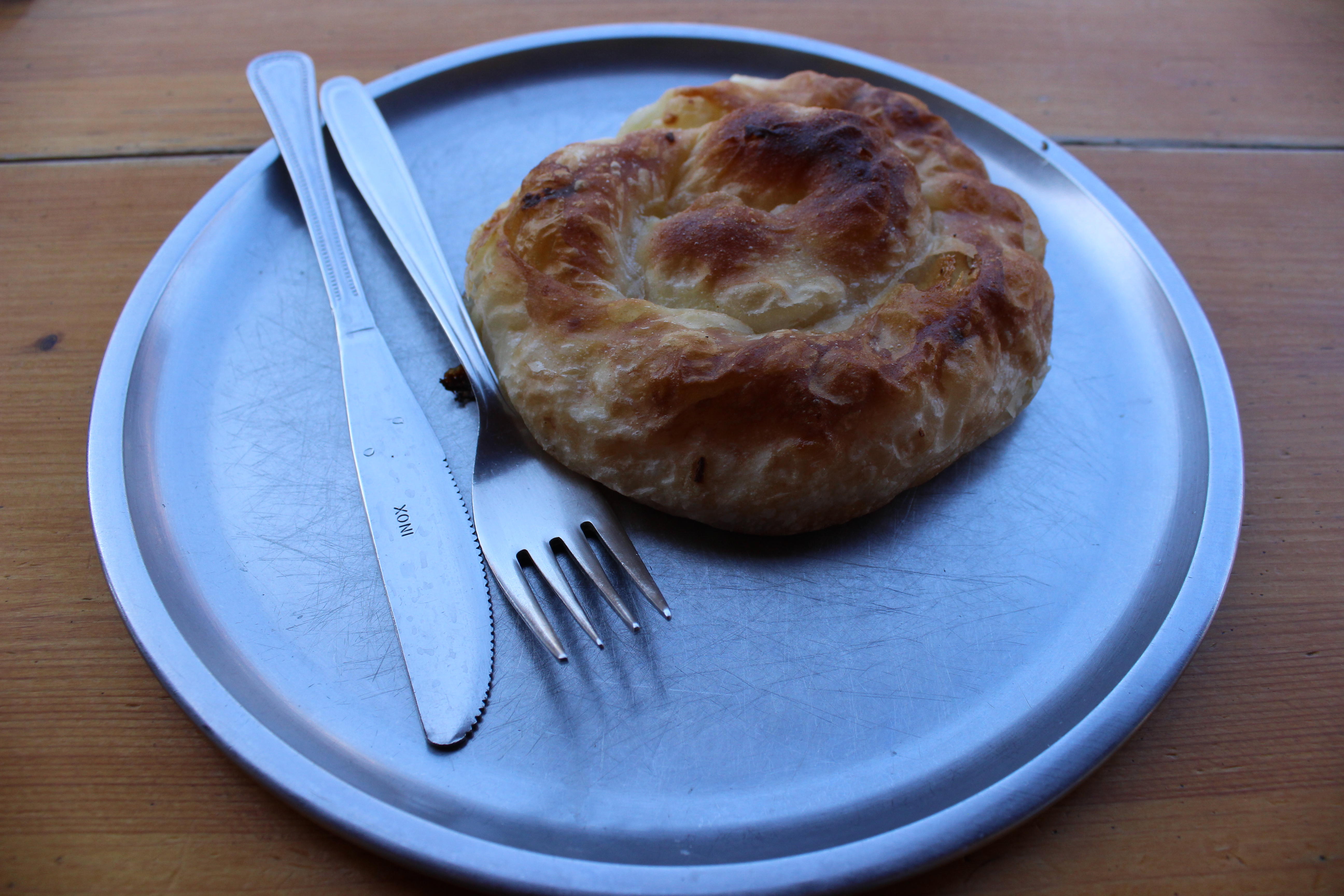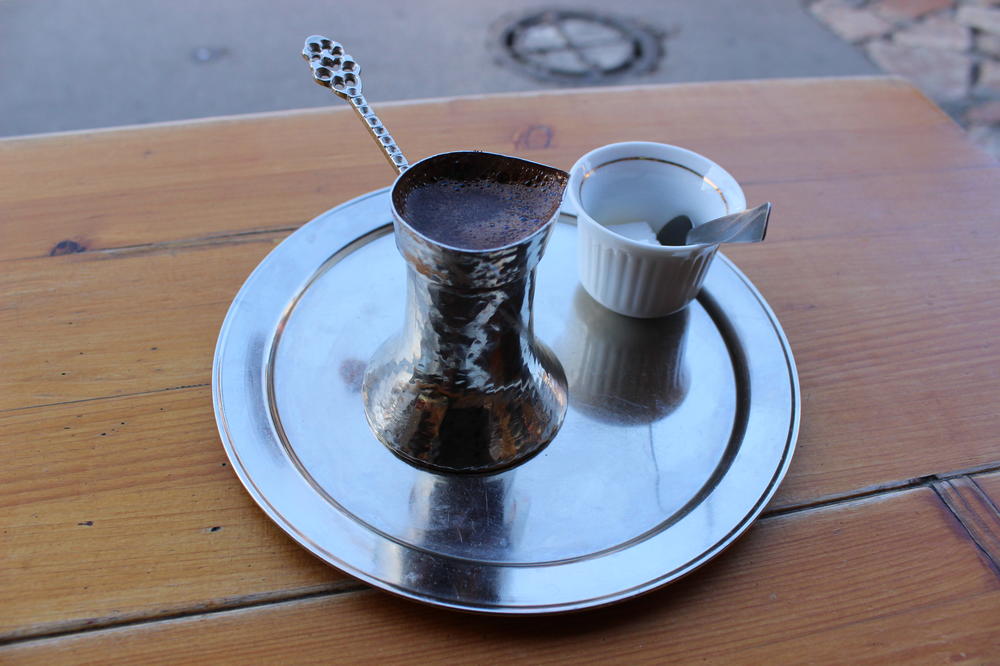Thomas Schad: "In Bosnia (I)"
Dec 10, 2015
In Bosnia, everything else was quite different from the Izmir experience. Bosnia was the starting and ending point of my Balkans tour, between Sarajevo’s Baščaršija, Mostar’s Old Bridge, Sandžak’s pešter heights and Ibar valley, Prizren’s multilingual place name signs, Macedonia’s shrub lands and Alexander the Great statues. Different were the little things: you drink čaj only in hastaluk („Tea? Are you ill?“). You always drink coffee there: Turkish coffee, the invasive Nes, the endemic form of espresso styled obična kafa. Different were also the big things, the whole thing: the mode.
While the mode in Izmir was sitting and writing, it was moving and speaking in the Balkans: like painting a picture here, and screening a movie there. I recorded interviews with many people, I took photographs of them, of me, of us. The mode alone had it: the feeling of there is no there there decreased with every conversation. In Macedonia, there was less there, and even there’s theres were changing like the weather. Sunny Montenegro, cloudy Macedonia.
Whenever I land in Sarajevo Butmir, I watch out for the B. family’s house, for the hotels in Ilidža, for the seminar house of Schüler Helfen Leben, where I used to have work sessions with B., planning the campaign, discussing fundraising, having endless coffee and cigarettes. Landing in Sarajevo feels like coming home and coming back, and it evokes all kind of emotional carnival. I think I still know more people in Sarajevo than in Berlin, and one of them, my former colleague J., offered me to stay at her place. But at the airport, I felt the sudden urge to book a hotel room for the first day and night. I told J. that I would come tomorrow, and I found a cheap and central hotel in the Mula Mustafa Bašeskija street, close to Ferhadija and Baščaršija, in the Ottoman heart of the city. I took a cab from the airport to the hotel. In the car, I answered dozens of questions, in a way that led me appear like a stranger with proper language skills in Nashyezik.
Taken for not too familiar with Bosnia, the cab driver gave me an introductory lecture on Sarajevo as a former hub of culture in Yugoslavia; On the Winter Olympics of 1984; On the general grandeur of former Yugoslavia; On the merits of the great leader Tito; On nowadays’ widespread corruption and the holistic misery all over former Yugoslavia. The war years were not part of the lecture. The dramaturgic climax of his monologue culminated in what was now, and what was now, was that the complete country was in a mess — not without stressing how beautiful everything was before:
„In Yugoslavia, you could travel to every corner of the country without fear. People had smiling faces. You could sleep at any parking lot. Nowhere, never did we lock our doors. When I was young, we used to eat and drink with friends from Serbia, from Croatia, from Macedonia, on the Adriatic coast. My enterprise sent me, my colleagues, all our families, on holidays to our beautiful coast. It was still our coast, then. What were Czechs, Poles, Hungarians, compared to us? Bulgarians, Romanians! What did they have? Nothing did they have! What did they understand about socialism? Nothing! East Germany! We had it all! We had socialism, we had health care for free, but we weren’t insane. We had Coca Cola, and we were proud of our passports, we could travel to the East and to the West without visa, we were welcome everywhere. I used to take my kids to Trieste to buy them farmerke (Jeans), whenever I wanted to. And now? Look at me, look at this country! I have to show my papers when I go to Dubrovnik! We are all ill, and we are tired. And what do we have now? This is not a country, this is disgrace! And what we have, is in the hands of Sandžaklije, look at this tower! The urban raja[1] has given up the city!“

The Radon tower in Sarajevo, owned by Fahrudin Radončić, originally from Sandžak.
And what were I doing in Sarajevo, he asked? - I am writing on a re-discovery of the Balkans, I said, and that it had to do with migrant Sandžaklije; that I was working in Berlin, the Balkans, and Istanbul. He said he had relatives in Berlin and Istanbul.
Most Bosnians have relatives in diaspora. I thought of my own family, of migration, of migration as the topic of my thesis, of my migrating thesis, of my migrating black notebook, filled with migrating manuscripts, about if and how this conversation would become part of my travel notes.
To unveil the robust layer of structuring memories from childhood, from my post-adolescent Sarajevo years, I didn’t tell my relatives and friends in Bosnia that I was staying over in a hotel. I badly wanted to see Sarajevo with a stranger’s eyes, to capture it from a photographer’s lens; I wanted to feel like a tourist on trip advisor, I wanted to taste Pita and Baklava in Baščaršija, as if I hadn’t grown up with it. At least for the first day and night.

Pita in the Baščaršija.
At the hotel reception, a friendly lady with that typical Sarajevan accent said that the weather was strange. As strange as across the year: first, they faced an unprecedented flood catastrophe in late spring, and now, the quince trees wanted to blossom in November. She borrowed a phrase from the popular Sevdalinka[2] Snijeg pade na behar na voće, suggesting that there may even fall snow on ripe fruits in next spring.
I came from another weather: this morning was grey and rainy in Berlin, where the fallen tree leaves were spreading their earthy smell. I tried to keep a friendly distance, I listened more than I spoke. The lady received my dog-eared passport, my fore and last name did the rest, my German accent made her smile — I was other. She was sweet and friendly with me, and she behaved more regular and distanced with local guests. I got what I ordered, and I completed my habitus. I chose beige hiking pants, an anachronistic colorful batik shirt, a bumbag, and a very visible camera. My outdoor coat was sparkling in communist red. In this touristic masquerade, I went on to rediscover Sarajevo, lusting for unspent, fresh impressions, taze (fresh) like somuni (flatbread) from the bakeries of Kovači.
I took pictures of Baščaršija, Sarači, the Gazi Husrev Beg mosque, Turkish grocery stores, Turkish-Bosnian friendship memorabilia, I ordered Pita (Börek in its Bosnian vest) and Turkish coffee, I took pictures of the cathedral, of the tramway, of the eternal flame, of random pedestrians. I rested at the emblematic fountain Sebilj and photographed it, imagining how I would juxtapose the photograph to a picture of Izmir’s Sebilj. I wandered from sokak to čikmaz, I discovered a new bridge on river Miljacka, I found the Akademija building invaded by an Apple store, I found myself bewildered by another new shopping center’s light pollution. Having coffee and scrolling through my Sarajevo centered news feed, I tried to situate my impressions within current developments in the public discourse and media.
I read that Saudis were increasingly spreading their petrodollars in Bosnia’s Muslim-Croat federation. A TV news clip was circulating, showing Gulf Arabs, the men wearing T-Shirts, the women veiled in black abayas, on their touristic discovery of Bosnia, rhapsodizing about the sheer greenness of the country. An Arab woman said: „We come to Bosnia because it is green and muslim.“ The speaker highlighted that one of the „major shortcomings“ in Bosnia was the absence of high class hotels, stressing the importance of further investments from the gulf countries.The light polluting shopping center is the opus of the Al Shiddi Trading Establishment from Riyadh, whose grotesque building is praised an „investment“ by the „investors“, on a memorial stone next to the shopping center. Its homepage calls the building a „present to the citizens of Sarajevo“. The complex, called Sarajevo City Center, met one of Bosnia’s „major shortcomings“ with a high class hotel on its top floor.
The next day, I have enough from the touristic intermezzo, and move to J.’s place. J. lives on Koševsko brdo, with a view on the olympic Bjelašnica mountains and the railway station. Since J. is working for a transnational television chain, we discuss many different issues from the news feed, especially Germany and Turkey related topics. J., who had been spending some of the war years and her late childhood as a refugee in Germany, was preparing an emission on the fall of the Berlin Wall, and I try to connect her with possible interlocutors from Berlin. A warm wind blows through the open window, the sun is shining, and Bjelašnica is completely free of snow. We sit at the table, each of us scrolling on their touch pads, checking the news, and I comment on a current strike of the German railway union, and how it had infuriated many people in Germany. I complain about rampant neoliberal policies, and the general state of the German railways.
J. sheds a wondering gaze at me. She stands up and asks me to follow her to the balcony, where she points her forefinger to a storage siding close to the central station. I see a long row of light rail wagons. J. says: „Can you imagine? They bought a brand new train, and only when it was brought to Sarajevo, they realized that it doesn’t fit the tracks. What a waste of money! This can only happen in our land (samo kod nas).“
After more than a week at J.’s place, I was reminded that there, in Bosnia, were also us, and I came to cherish this connection, upon a phone call of my migrant mother in Germany to her migrant sister in Austria. My aunt, in the Alpine skiing resort, asked my mother in Franconia: When will we see your son again? Will he ever visit us? Is he in Berlin, is he in Istanbul? Where is he? My mother probably said: We know him. He always does what he wants, and now he is sleeping on a friend’s couch in Sarajevo (kaže mama da spavaš na kauču).
I was sleeping on my friend’s couch, but I was also a son and a nephew and a cousin and a grandson, in Bosnia, where I could, besides raja, relate to relatives, from Bosnia — whether in Bosnia, in Austria, in Germany, in Istanbul, in America, ore elsewhere. I moved deliberately in the transnational space. I used Facebook a lot, and on my mother’s advise, I chatted with my cousin, I called my uncle in Austria, and now, there was the furnished flat of my uncle’s mother. In Grbavica.
And this is what Bosnia gave to us: a transnational social space. We are also — some more, and some less — from Bosnia. My cousin was born in Austria, but she is also from Bosnia. I was born, as a twin brother, in Germany, but I am also from Bosnia. My twin sister feels, perhaps, a bit less from Bosnia, because I have spent more time there. I know Sarajevo well, I know shortcuts, back alleys, slang words — I have raja there. I feel embraced and home there. While most visitors without Nashyezik cannot pronounce Grbavica — I even had a flat there. I had spent a week in that Grbavica flat in 1998, with its owners, with my relatives, with Ivana and Selim. But now, Ivana and Selim were not there anymore. Ivana is pokojna, and Selim rahmetli.
There, in Bosnia, you can distinguish people’s deaths by knowing their names. As long as there is tradition.
[1] The Bosnian word raja originates from the Ottoman reaya or râya (رعايا), and it originally designated non-Muslim subjects. As in many other cases, the meanings of the word have changed, and its contemporary meanings either refers to anybody who is considered to be a member of the urban community, or to friends and acquaintances, regardless of their religious affiliation. In the context of the taxi driver’s monologue, raja is used as a differentiator: Sandžaklije – immigrants from the Muslim area of Sandžak in neighbouring Serbia and Montenegro – are marked as outsiders, whereas raja refers to established city dwellers, which reflects a wide spread stereotype in BiH.
[2] Sevdalinka or Sevdah is a music genre from Bosnia-Herzegovina and part of a music continuum stretchin all over the neighbouring lands, and it is often said to be a sister genre of Portuguese Fado and Anatolian-Greek Rembetiko, being a potpourri of Slavic, Oriental, Sephardic, Roma, and other influences. Sevdah and its current revival by artists like Damir Imamović, Amira Medunjanin, Božo Vrećo and others deserves a separate article – soon on my blog.


